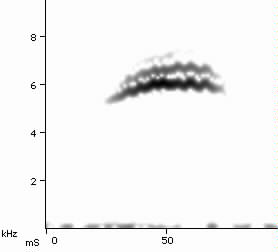
Yellow-rumped Warbler Dendroica coronata
Flight call description A slightly sibilant and slightly rising "vsee" with a whistled quality. Also regularly gives its chip note, a flat "chep" or "chek" in diurnal flight (see Behavior and Subspecies).
Fig.1. Maryland October 7, 1994 (MO).
"Myrtle" Warbler flight call from bird in flight.
Fig.2. Michigan July 26, 2000 (WRE).
"Myrtle" Warbler chip note from bird in flight.
Fig.3. Arizona January 26, 2001 (WRE).
"Audubon's" Warbler chip note from perched bird.
Similar species Generally longer and lower-pitched than the "double-banded up-seep" group. See Blue-winged, Golden-winged, and Mourning Warblers, Ovenbird, and short rising seeps.
Behavior Primarily a nocturnal migrant but engages in redetermined migration and resumed migration. In addition to it's standard flight call, the Yellow-rumped Warbler also gives its chip note regularly in diurnal flight (see Subspecies). In fact, in diurnal flight, the chip note is often given more frequently than the "vsee" flight call and is probably the most familiar call given by any warbler in flight. We therefore include it here though we do not consider it a standard flight call. This chip note is only seldom given by nocturnal migrants. The "vsee" flight call is given regularly both day and night.
Subspecies The chip note of "Myrtle" Warbler (D. c. coronata) is a strong, flat "chep" or "chek". "Audubon's" Warbler (D. c. auduboni) gives a higher, huskier, more rising "whik". Intermediate calls occur. The "vsee" flight calls of "Myrtle" and "Audubon's" Warblers are similar.
Spectrographic description Measured calls (N=20) were 39-76.3 (60.2) mS in duration and in the 5.3-8.9 (5.8-7.8) kHz frequency range. The frequency track was rising and typically showed a faint second band (less often a single band or bold double band). A fine modulation was typically evident in the latter half of the call, or less often throughout the call, with a spacing of 5.3-7.5 (6.4) mS between humps.